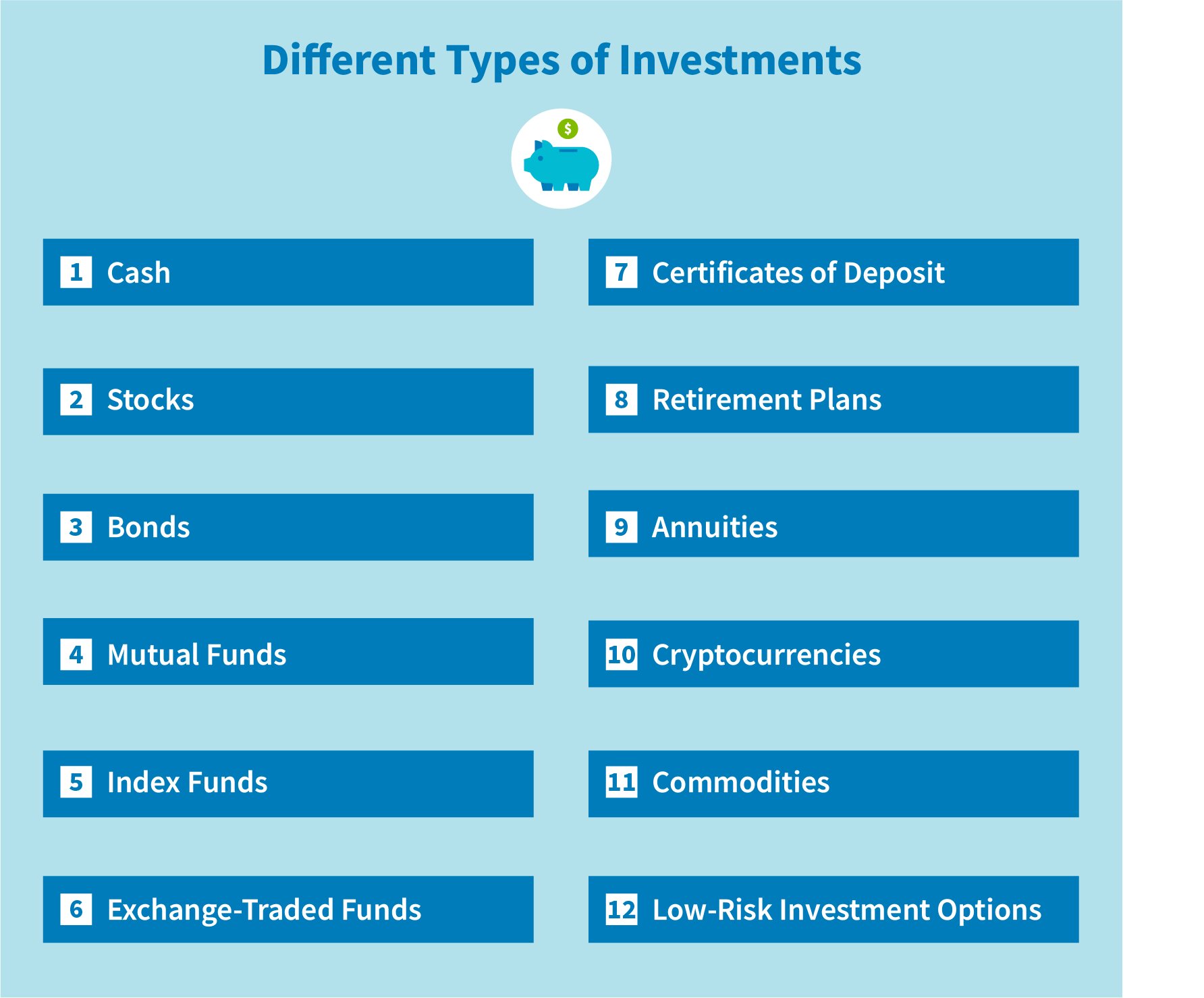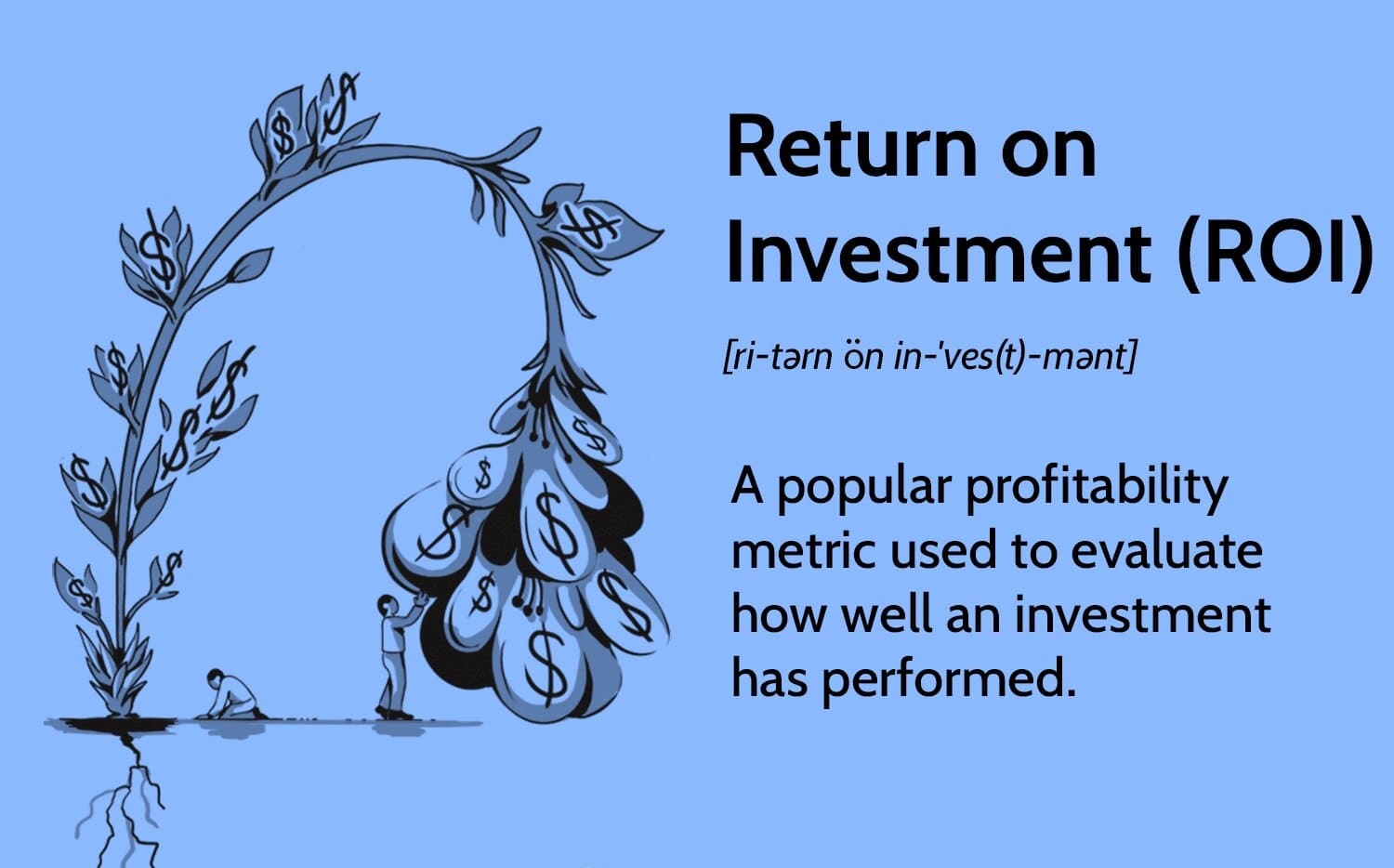Introduction
Investing in the stock market can be a lucrative way to grow your wealth and achieve financial goals. However, before diving into the world of stock investments, it is essential to understand the different types of stocks available. Each type has its own characteristics, risk levels, and potential for returns.
Stock investments grant ownership in a company and provide potential for capital appreciation and dividends. By investing in stocks, individuals can become shareholders and have a stake in the company’s success. It is important to note that stock investing comes with risks, including market volatility and the potential for loss.
There are several types of stock investments to consider, each catering to different investment goals and risk tolerances. This article will explore some of the most common types of stock investments, ranging from widely recognized blue-chip stocks to speculative penny stocks. Understanding these different investment options can help investors make informed decisions based on their financial objectives and risk appetite.
When evaluating stock investments, it is crucial to conduct thorough research, analyze financial statements, assess market conditions, and consider the company’s long-term prospects. Diversifying a portfolio across various stock types can help mitigate risk and maximize potential returns. Now, let’s explore the different types of stock investments in more detail.
Common Stocks
Common stocks are the most widely known type of stock investment. When you buy common stock, you become a partial owner of the company and have voting rights at shareholder meetings. Common stockholders also have the potential to receive dividends, although companies are not obligated to pay them.
Investing in common stocks provides the opportunity for capital appreciation, as the value of the stock can increase over time. However, common stocks also come with higher risk compared to other types of stocks. If the company performs poorly or faces financial challenges, the value of common stock can decline.
One key advantage of investing in common stocks is the ability to participate in the growth and profitability of the company. As the business succeeds and increases its earnings, the value of the stock may rise, resulting in potential gains for the investor. Common stockholders may also benefit from stock splits, which can increase the number of shares they hold.
However, it is important to note that common stockholders are at the bottom of the priority list in case of bankruptcy or liquidation. If the company faces financial difficulties and needs to repay creditors, common stockholders may lose their investment.
Common stocks are suitable for investors who have a long-term investment horizon, are willing to take on higher risk, and have confidence in the company’s growth potential. As common stocks offer the potential for higher returns, they can be a valuable component of a diversified investment portfolio.
Preferred Stocks
Preferred stocks differ from common stocks in several key aspects. While common stockholders have voting rights, preferred stockholders do not typically have the same privileges. Instead, preferred stockholders have a higher claim on the company’s assets and earnings compared to common stockholders.
One of the primary advantages of investing in preferred stocks is the preference given to shareholders when it comes to receiving dividends. Preferred stockholders generally receive fixed dividend payments on a regular basis, and these payments take priority over common stock dividends. However, it is important to note that companies are not obligated to pay dividends on preferred stocks.
In the event of a company’s liquidation or bankruptcy, preferred stockholders have a greater chance of recouping their investment compared to common stockholders. They have a higher claim on the company’s assets, which provides a level of protection for their investment.
Preferred stocks are often considered a hybrid investment, combining characteristics of both stocks and bonds. They typically offer a fixed dividend rate, which makes them more similar to bonds in terms of income generation. However, unlike bonds, preferred stocks do not have a fixed maturity date.
While preferred stocks offer a more stable income stream compared to common stocks, they also tend to have limited potential for capital appreciation. The value of preferred stocks is often influenced by changes in interest rates, making them more sensitive to market fluctuations.
Investors who prefer a steady income stream and prioritize capital preservation may find preferred stocks attractive. They offer a balance between the potential for regular income and a level of security in terms of asset priority. However, it is crucial to conduct thorough research and evaluate the financial strength of the company issuing the preferred stocks before making an investment decision.
Blue-Chip Stocks
Blue-chip stocks are shares of well-established, financially stable companies with a strong reputation for reliability and consistent performance. These companies are typically leaders in their respective industries, known for their long history of success and market dominance.
Investing in blue-chip stocks offers several benefits. First, these stocks are considered to be relatively low-risk investments compared to smaller, riskier companies. Blue-chip companies have proven track records of delivering steady growth and have weathered various market conditions.
Another advantage of blue-chip stocks is their ability to provide reliable dividends. These companies often have a history of consistently paying dividends to their shareholders, making them attractive to income-oriented investors. The dividends can provide a stable income stream, especially for those seeking passive income or looking to supplement their retirement funds.
Blue-chip stocks are also sought after for their potential for capital appreciation. As market leaders with substantial resources, they have the capacity to adapt to changing business environments and pursue new growth opportunities. This resilience and ability to innovate can translate into long-term share price appreciation.
Furthermore, blue-chip stocks are generally more liquid, meaning they can be bought and sold easily on the stock market. This liquidity provides investors with the flexibility to enter or exit positions without significant impact on the stock’s price.
Investing in blue-chip stocks can be suitable for conservative investors who prioritize stability and consistent returns. These stocks often form the core holdings of many investment portfolios, serving as a foundation for building long-term wealth.
However, it is important to note that even blue-chip stocks are not immune to market volatility and economic downturns. Investors should still conduct thorough research and analysis to ensure the underlying fundamentals of the company remain strong before making investment decisions.
Growth Stocks
Growth stocks are shares of companies that are expected to grow at an above-average rate compared to the overall market. These companies typically reinvest their earnings back into the company to fuel expansion, rather than distributing them as dividends to shareholders.
Investing in growth stocks offers the potential for significant capital appreciation. These stocks tend to have higher valuations due to investors’ expectations of future growth. As the company continues to perform well and exceed market expectations, the share price may rise accordingly, leading to potential returns for investors.
Growth stocks often belong to companies in sectors such as technology, healthcare, and consumer discretionary, where innovation and market disruption are prevalent. These companies are focused on developing new products or services, expanding into new markets, and gaining a larger market share.
One characteristic of growth stocks is that they may have higher volatility compared to other types of stocks. As investors’ expectations fluctuate and sentiment wavers, the share prices of growth stocks can experience sharp swings. Therefore, investing in growth stocks requires a long-term perspective, as short-term volatility should not deter investors from their investment thesis.
Investors interested in growth stocks are typically seeking capital appreciation rather than immediate income generation through dividends. By reinvesting earnings back into the business, growth companies aim to fund research and development, expand operations, and increase market presence.
It is important to conduct thorough research and evaluate the growth prospects of the company before investing in growth stocks. Factors such as market trends, competitive landscape, and the company’s ability to maintain its growth trajectory should be taken into consideration.
Investing in growth stocks can be suitable for investors with a higher risk tolerance and a longer investment horizon. While there is no guarantee of achieving high returns, carefully selected growth stocks can potentially outperform the broader market and deliver substantial gains over time.
Value Stocks
Value stocks are shares of companies that are considered to be undervalued by the market. These companies typically have solid fundamentals and stable operations but may be temporarily out of favor with investors, leading to a lower stock price relative to their intrinsic value.
Investing in value stocks is based on the belief that over time, the market will recognize the true worth of the company, leading to an increase in the stock price. Value investors seek to identify companies that are trading at a discount compared to their underlying assets, earnings, or cash flow.
One of the key characteristics of value stocks is the potential for capital appreciation. As the market sentiment towards the company improves and investors recognize its value, the stock price may rise, allowing investors to realize gains.
Value stocks often belong to mature companies in stable industries. These companies may have been overlooked or faced temporary setbacks, but they have solid fundamentals, strong cash flows, and a history of consistent performance.
Another advantage of investing in value stocks is the potential for dividends. Many value stocks offer attractive dividend yields, providing investors with a steady income stream while they wait for the market to recognize the stock’s value.
Investing in value stocks requires patience, as it may take time for the market to reflect the true worth of the company. It is important to thoroughly analyze the financial health, competitive position, and growth prospects of the company before making an investment decision.
Value stocks are often considered suitable for long-term investors who have a value-oriented approach and are willing to wait for their investment thesis to materialize. These stocks can be an important component of a diversified portfolio, providing stability and the potential for long-term capital appreciation.
Dividend Stocks
Dividend stocks are shares of companies that regularly distribute a portion of their earnings to shareholders in the form of dividends. These stocks are sought after by income-oriented investors who prioritize generating a steady income stream from their investments.
One of the primary advantages of investing in dividend stocks is the potential for consistent and reliable income. Dividends are typically paid quarterly or annually, providing investors with regular cash flows. This can be particularly appealing for retirees or investors looking for passive income to supplement their earnings.
Dividend stocks are often found in mature, stable industries where companies have a history of generating consistent earnings. These companies may have limited growth prospects but are established and reliable in their operations. Examples of dividend-paying industries include utilities, consumer staples, and real estate investment trusts (REITs).
Investors in dividend stocks should consider both the dividend yield and the dividend growth rate. The dividend yield represents the annual dividend payment as a percentage of the stock price. A higher yield is generally more attractive to income-oriented investors. However, it is important to balance the yield with the company’s ability to sustain and potentially grow its dividends in the future.
Dividend growth rate reflects the annualized increase in dividends over time. Companies that consistently increase their dividends demonstrate strong financial performance and a commitment to returning value to shareholders. Dividend growth offers the potential for income growth and can help investors protect their portfolios against inflation.
It is important for investors to assess the financial health and stability of the company before investing in dividend stocks. A company with a solid balance sheet, consistent cash flow, and a history of increasing dividends may be more likely to sustain its dividend payments even during economic downturns.
Dividend stocks can be a valuable component of a well-diversified portfolio, providing stability, income generation, and potential long-term capital appreciation. These stocks are suitable for income-oriented investors, retirees, or anyone seeking a steady income stream from their investment portfolio.
Small-Cap Stocks
Small-cap stocks are shares of companies with a relatively small market capitalization. These companies have a lower total market value compared to larger, more established companies. Investing in small-cap stocks can offer unique opportunities for growth-oriented investors.
One of the primary advantages of investing in small-cap stocks is the potential for significant capital appreciation. These stocks often have the potential to outperform larger companies in terms of percentage returns. Small-cap companies are typically in a growth phase, expanding their operations, and gaining market share.
Small-cap stocks can be more volatile compared to their larger counterparts. The share prices of small-cap stocks tend to be more sensitive to changes in market conditions, investor sentiment, or company-specific events. This volatility presents both risks and opportunities for investors.
Investing in small-cap stocks requires thorough research to identify companies with solid growth prospects and strong fundamentals. These stocks may offer an opportunity to invest in emerging industries or disruptive technologies where smaller companies have the potential to gain a competitive edge.
While small-cap stocks have the potential for outsized returns, it is important to note that they also carry higher risks. The smaller size of these companies may make them more susceptible to financial challenges or market downturns. As a result, diversification and careful analysis of individual companies are crucial when investing in small-cap stocks.
Investors who are willing to accept higher volatility and have a longer-term investment horizon may find small-cap stocks attractive. These stocks can be suitable for growth-oriented investors looking for potential opportunities in companies that have yet to reach their full potential.
It is important to note that liquidity can be a consideration when investing in small-cap stocks. The trading volume of these stocks may be lower compared to larger stocks, meaning it can be more challenging to buy or sell shares without affecting the price.
Small-cap stocks can be a valuable addition to a well-diversified portfolio, offering the potential for higher growth and returns. However, investors should carefully assess their risk tolerance and conduct thorough research before making investment decisions.
Mid-Cap Stocks
Mid-cap stocks are shares of companies with a market capitalization that falls between small-cap and large-cap stocks. These companies are often in the growth phase, transitioning from small start-ups to more established entities, and have the potential to offer a unique investment opportunity.
Investing in mid-cap stocks can provide a combination of growth potential and relative stability. These companies have already demonstrated some level of success and have the potential for further expansion. They may operate in niche markets or have strong growth prospects in their industry.
One advantage of investing in mid-cap stocks is the potential for higher returns compared to larger, more mature companies. As mid-cap companies continue to grow and increase their market share, their stock prices may experience significant upside potential. This growth potential can be attractive to investors seeking capital appreciation.
Mid-cap stocks also tend to have higher liquidity compared to small-cap stocks. This means investors may have an easier time buying and selling shares without significantly impacting the stock’s price. The increased liquidity can provide a level of flexibility and efficiency in executing investment strategies.
While mid-cap stocks offer growth potential, they may carry a higher level of risk compared to large-cap stocks. These companies can still be exposed to economic uncertainties and industry-specific challenges. Therefore, careful research and analysis are essential when selecting mid-cap stocks for investment.
Investing in mid-cap stocks is suitable for investors who are willing to take on a moderate level of risk in pursuit of higher potential returns. It can be an attractive option for those who want exposure to companies with growth potential but with some level of stability compared to small-cap stocks.
It is important to note that diversification remains crucial when investing in mid-cap stocks or any other asset class. Spreading investments across different industries and market segments can help mitigate risk and enhance overall portfolio performance.
Mid-cap stocks can offer a compelling investment opportunity for investors seeking a balance between growth potential and moderate risk. By identifying companies with solid growth prospects, investors can participate in their continued expansion and potentially enjoy favorable returns.
Large-Cap Stocks
Large-cap stocks refer to shares of companies with a significant market capitalization. These are typically well-established, recognized companies with stable operations and a long track record of success. Investing in large-cap stocks offers a combination of stability, liquidity, and potential for consistent returns.
One of the key advantages of investing in large-cap stocks is the relative stability they provide. These companies are often market leaders in their respective industries, with established business models, extensive resources, and a wide customer base. Large-cap stocks tend to be more resilient during economic downturns, making them attractive for conservative investors.
Large-cap stocks are generally considered less volatile compared to smaller-cap stocks. This stability can offer investors a level of confidence and predictability, particularly during times of market uncertainty. The lower volatility can make it easier to plan long-term investment strategies and protect the value of the portfolio.
Another benefit of large-cap stocks is their higher liquidity. Due to their widespread popularity and significant market presence, large-cap stocks tend to have higher trading volumes. This makes it easier for investors to buy and sell shares without significantly impacting the stock’s price. The liquidity allows for efficient execution of investment strategies.
Large-cap companies often pay regular dividends to their shareholders. As financially stable entities with consistent profitability, they have the capacity to distribute a portion of their earnings back to investors in the form of dividends. Dividend payments can provide a steady income stream for investors, appealing to those seeking regular income.
Investing in large-cap stocks can be suitable for both growth-oriented investors and income-oriented investors. These stocks offer the potential for long-term capital appreciation as well as income generation through dividends. They can form the core holdings of an investment portfolio due to their stability and lower risk compared to small-cap or mid-cap stocks.
While large-cap stocks offer stability, it is still essential for investors to analyze the fundamentals and growth prospects of individual companies. Factors such as industry trends, competitive landscape, and management competence should be considered before making investment decisions.
Large-cap stocks can be a prudent investment choice for investors seeking a combination of stability, liquidity, and potential for consistent returns. By investing in well-established companies, investors can participate in the success of market leaders and potentially benefit from long-term wealth accumulation.
Penny Stocks
Penny stocks are shares of small companies with a low market price, typically trading at a few cents or a few dollars per share. These stocks often have a small market capitalization and are considered highly speculative investments.
One of the primary characteristics of penny stocks is their volatility. These stocks can experience abrupt price fluctuations due to their low trading volumes and limited market liquidity. As a result, penny stocks can offer the potential for significant gains, but they also come with higher risks.
Penny stocks are often associated with companies that are in the early stages of development, have limited operating history, and may have uncertain prospects. These companies may be engaged in emerging industries, speculative ventures, or have financial difficulties. Investing in penny stocks requires thorough research to evaluate the company’s management, financial health, and growth potential.
Due to their low price and volatility, penny stocks attract speculative traders and day traders looking for short-term profits. However, the unpredictable nature of penny stocks makes them highly risky, and investors should exercise caution when considering these investments.
It is crucial for investors to be aware of the risks associated with penny stocks, including the potential for fraud, manipulation, and illiquidity. The lack of readily available information and low trading volumes can make it challenging to buy or sell shares at desired prices.
Investing in penny stocks requires a high tolerance for risk and a willingness to conduct thorough due diligence. It is advisable to establish strict risk management strategies, such as setting stop-loss orders or limiting exposure to a small portion of the portfolio.
Penny stocks are not suitable for conservative investors or those seeking stable long-term investments. However, for individuals with a high-risk appetite and the ability to closely monitor and analyze market trends, penny stocks can offer speculative opportunities for potential gains.
It is important to exercise caution and consult with a qualified financial advisor when considering investments in penny stocks. Due diligence, research, and a thorough understanding of the risks involved are essential before entering into any penny stock investment.
International Stocks
International stocks refer to shares of companies that are based outside of an investor’s home country. Investing in international stocks offers the opportunity to diversify a portfolio and gain exposure to a broader range of industries, economies, and market cycles.
One of the primary advantages of investing in international stocks is the potential for higher returns compared to domestic stocks. By expanding investment horizons beyond one’s home country, investors can tap into the growth and development of emerging markets or invest in well-established companies in foreign markets.
International stocks provide access to different sectors and industries that may not be well-represented in the domestic market. This diversification can reduce risk by spreading it across different geographic regions and decreasing the impact of local market fluctuations.
Investing in international stocks also offers the potential for currency diversification. Fluctuations in exchange rates can impact investment returns. By holding stocks denominated in different currencies, investors can potentially benefit from currency movements and hedge against currency risks.
When investing in international stocks, it is important to consider the unique risks associated with foreign markets. These risks include political instability, regulatory differences, changes in economic conditions, and currency exchange rate fluctuations. Thorough research and understanding of the particular country’s political and economic landscape are essential.
There are different ways to gain exposure to international stocks, including investing directly in individual companies listed on foreign exchanges or through mutual funds and exchange-traded funds (ETFs) that focus on international markets. These investment vehicles allow investors to access a broader range of international stocks and provide professional management of the portfolio.
Investing in international stocks requires careful evaluation of the companies, their financial health, and their potential growth prospects. Understanding the cultural, economic, and political context of the country is crucial in making informed investment decisions.
International stocks can be a valuable addition to a well-diversified portfolio, providing exposure to global growth opportunities and potentially enhancing returns. However, it is important to assess the risks and opportunities presented by different international markets and to consult with a qualified financial advisor when considering international investments.
Exchange-Traded Funds (ETFs)
Exchange-Traded Funds (ETFs) are investment vehicles that pool together funds from multiple investors to invest in a diversified portfolio of assets, such as stocks, bonds, or commodities. ETFs are traded on stock exchanges, providing investors with the flexibility to buy and sell shares throughout the trading day at market-determined prices.
ETFs offer several advantages over traditional mutual funds. One key advantage is their diversification. ETFs typically hold a basket of different securities, providing investors with exposure to a wide range of individual stocks or bonds. This diversification helps to spread risk and can reduce the impact of volatility in a single asset.
Another advantage of ETFs is their transparency. Unlike mutual funds, which disclose their holdings periodically, ETFs disclose their holdings on a daily basis. This transparency allows investors to know exactly what assets they own at any given time.
ETFs also provide investors with the ability to access specific markets, sectors, or asset classes. There are ETFs that track major stock market indices, such as the S&P 500, allowing investors to gain exposure to the overall stock market. Additionally, ETFs exist to target specific sectors, industries, or regions, enabling investors to customize their investment strategies.
One of the notable features of ETFs is their liquidity. Since ETFs are traded on stock exchanges, investors can buy and sell shares throughout the trading day at market prices. This liquidity offers flexibility and allows investors to capitalize on short-term trading opportunities or adjust their investment positions as market conditions change.
ETFs also tend to have lower expense ratios compared to traditional mutual funds. By tracking an index rather than relying on active management, ETFs generally have lower operating costs, resulting in lower expense ratios for investors.
Investing in ETFs can be suitable for both novice and experienced investors. Their flexibility, diversification, transparency, and potential cost savings make them appealing to a wide range of individuals.
However, it is important to conduct research and due diligence before investing in ETFs. Investors should consider factors such as the ETF’s expense ratio, tracking error, management style, and underlying holdings. Understanding the investment objective and strategy of an ETF is crucial in aligning it with one’s own investment goals.
ETFs have become increasingly popular investment vehicles due to their convenience, cost-effectiveness, and flexibility. They provide investors with access to a diverse range of assets and markets, allowing them to build well-diversified portfolios that align with their investment objectives.
Mutual Funds
Mutual funds are investment vehicles that pool money from multiple investors to invest in a diversified portfolio of securities, such as stocks, bonds, or a combination of both. These funds are managed by professional fund managers who make investment decisions on behalf of the investors.
One of the primary advantages of mutual funds is their diversification. By pooling together funds from numerous investors, mutual funds can spread investment across a wide range of assets. This diversification helps to mitigate risk by reducing the impact of any single investment’s performance on the overall portfolio.
Mutual funds can be suitable for both novice and experienced investors who prefer a hands-off approach to investing. The fund manager conducts research, selects investments, and manages the portfolio on behalf of the investors. This allows individual investors to benefit from the expertise and professional management of the fund manager.
Mutual funds provide investors with access to various investment strategies and asset classes. There are mutual funds that focus on specific sectors, such as technology or healthcare, or that target specific regions or countries. These funds allow investors to tailor their portfolios to their specific investment beliefs or goals.
Another advantage of mutual funds is their liquidity. Investors can buy or sell mutual fund shares at the net asset value (NAV) at the end of each trading day. This makes it easy for investors to enter or exit positions, providing them with flexibility and the ability to adjust their investment allocations as needed.
Some mutual funds also offer the option of systematic investment plans (SIPs) or systematic withdrawal plans (SWPs). SIPs allow investors to regularly invest a fixed amount, while SWPs allow them to withdraw a specific amount at regular intervals. These features can help investors set up disciplined investment practices or generate regular income from their investments.
Investing in mutual funds does come with certain considerations. Investors should assess factors such as the fund’s objectives, past performance, expense ratio, and the fund manager’s track record. Additionally, investors should be aware of any fees associated with the purchase or sale of mutual fund shares.
Mutual funds can be an effective tool for long-term wealth creation and diversification, allowing investors to access professional management and a broad range of investment opportunities. However, it is essential for investors to select mutual funds that align with their investment objectives and to regularly monitor the performance of their investments within the fund.
Index Funds
Index funds are mutual funds or exchange-traded funds (ETFs) that aim to replicate the performance of a specific market index, such as the S&P 500 or the FTSE 100. These funds invest in a portfolio of securities that mirror the composition and weightings of the chosen index, providing investors with broad market exposure.
One of the primary advantages of index funds is their low costs. Since index funds aim to match the performance of the underlying index rather than relying on active fund management, they typically have lower expense ratios compared to actively managed funds. The lower costs can have a significant impact on investment returns over the long term.
Index funds offer investors an easy and efficient way to gain exposure to a broad market or specific market segment. By replicating the performance of a market index, investors can participate in the overall market’s returns without needing to select individual stocks or constantly monitor the portfolio.
Another advantage of index funds is their diversification. By tracking an index, these funds typically hold a large number of securities across different sectors and industries. This diversification helps to spread risk and reduce the impact of any single security’s performance on the portfolio’s overall returns.
Transparency is another key feature of index funds. Since the composition of the underlying index is predetermined and publicly available, investors can easily assess the holdings and understand the strategy of the fund. This transparency allows investors to have a clear understanding of what they are investing in and helps to make informed investment decisions.
Index funds can be suitable for a wide range of investors. For novice investors, these funds provide a simple and cost-effective way to enter the market and build a diversified portfolio. Experienced investors may also incorporate index funds as a core component of their investment strategy, utilizing them to gain exposure to specific sectors or to complement their active investment strategies.
While index funds offer broad market exposure, they are not immune to market volatility and fluctuations. Investors should still consider factors such as their investment goals, risk tolerance, and time horizon when selecting index funds. Additionally, investors should be mindful of the tracking error, which measures the extent to which the fund’s returns deviate from the performance of the underlying index.
Index funds have gained popularity as an effective investment tool for those seeking low costs, broad market exposure, and simplicity in their investment strategy. By tracking a market index, index funds offer a passive investment approach that can align with long-term wealth creation and provide investors with convenient access to the overall market’s returns.
Sector Funds
Sector funds are mutual funds or exchange-traded funds (ETFs) that focus on investing in a specific sector or industry. These funds concentrate their investments in companies that operate within a particular sector, such as technology, healthcare, energy, or consumer discretionary.
One of the primary advantages of sector funds is the opportunity for targeted exposure to a specific sector or industry. By concentrating investments in a particular sector, investors can capitalize on the growth potential and trends within that industry. This can provide the potential for higher returns compared to more diversified funds.
Sector funds allow investors to express their views or opinions about specific sectors or industries. For example, an investor who believes in the growth prospects of the technology sector may choose to invest in a technology sector fund. This allows them to align their investment strategy with their market outlook.
Investing in sector funds can serve as a complement to a diversified portfolio. By adding sector funds, investors can further diversify their holdings and potentially reduce risk. Sector funds can provide exposure to industries that may not be well-represented in broader market indices.
However, it is important to recognize that sector funds come with their own set of risks. Investing in a specific sector means that the portfolio is more susceptible to the performance and fluctuations of that sector. If the chosen sector experiences a downturn, the value of investments in the sector fund may decline.
Investing in sector funds can be suitable for investors who have a good understanding of specific sectors, follow industry trends closely, or have a strong conviction about the growth potential of a particular sector. It is essential to conduct thorough research and analysis before investing in sector funds to assess the sector’s risks and growth prospects.
Investors should also consider the potential overlap between sector funds and their existing portfolio. If a portfolio already has significant exposure to a specific sector through other investments, adding a sector fund that focuses on the same sector may lead to overconcentration of risk.
Like with any other investment, it is important to regularly monitor the performance of sector funds to ensure they continue to align with investment goals and market conditions. Investors should be prepared to make adjustments to their investment portfolio as needed based on changing market dynamics or individual sector performance.
Sector funds offer investors the opportunity to target specific sectors or industries and potentially benefit from their growth potential. However, careful evaluation of the sector’s prospects and risk factors is necessary to make informed investment decisions and maintain a well-diversified portfolio.
Real Estate Investment Trusts (REITs)
Real Estate Investment Trusts, also known as REITs, are investment vehicles that allow individuals to invest in real estate properties without having to directly own or manage them. REITs pool funds from multiple investors to invest in income-generating real estate assets, such as residential, commercial, or industrial properties.
One of the primary advantages of investing in REITs is the potential for regular income. REITs are required by law to distribute a significant portion of their taxable income to shareholders in the form of dividends. This consistent income stream can be particularly attractive for income-oriented investors, such as retirees or individuals seeking passive income.
REITs provide investors with access to a diversified portfolio of real estate properties. By investing in REITs, individuals can gain exposure to a wide range of properties, including office buildings, shopping centers, apartments, hotels, and more. This diversification helps to spread risk across different property types and locations, reducing vulnerability to changes in a specific real estate market.
Investing in REITs offers convenience and liquidity. REITs trade on major stock exchanges, allowing investors to easily buy and sell shares at market-determined prices. Unlike purchasing physical real estate, which can be time-consuming and involve significant capital, investing in REITs provides a more accessible and hassle-free way to participate in the real estate market.
Another advantage of REITs is their potential for capital appreciation. As properties held by REITs appreciate in value over time, the share prices of the REITs can also increase, offering investors the opportunity for capital gains. Additionally, some REITs may engage in property development or redevelopment projects, which can potentially further enhance their value.
However, it is important to consider the risks associated with investing in REITs. REITs can be affected by changes in the real estate market, interest rates, economic conditions, and other factors that impact property values and rental income. Investors should research the quality of the REIT’s management team, the properties in its portfolio, and the overall market conditions before making investment decisions.
Investing in REITs can be suitable for individuals who seek exposure to the real estate market without the responsibilities of direct property ownership. REITs can offer a convenient and income-generating investment option, providing diversification, potential for capital appreciation, and a consistent stream of dividends.
It is important for investors to carefully evaluate the specifics of each REIT and assess their own investment goals, risk tolerance, and time horizon. Consulting with a financial advisor can help investors make informed decisions and develop a real estate investment strategy that aligns with their overall portfolio objectives.
Bonds
Bonds are fixed-income securities that represent a loan made by an investor to a borrower, typically a corporation, municipality, or government entity. When an investor purchases a bond, they are essentially lending money to the issuer in exchange for periodic interest payments and the return of the principal amount at maturity.
One of the primary advantages of investing in bonds is the potential for income generation. Bonds pay periodic coupon payments to investors, providing a steady stream of income. The coupon rate is predetermined at the time of issuance and is based on factors such as the creditworthiness of the issuer and prevailing market interest rates.
Bonds are often considered less risky compared to other investment options, such as stocks. When investing in bonds issued by reputable issuers, there is generally less volatility in their price compared to equity securities. As a result, bonds can provide investors with more stability and preservation of capital.
Bonds can also play a crucial role in diversifying an investment portfolio. They have historically exhibited a lower correlation with stocks, meaning that bond returns may not move in lockstep with stock market fluctuations. Including bonds in a portfolio can help reduce overall portfolio risk and increase its resilience during market downturns.
Another advantage of investing in bonds is their relative transparency. The terms and conditions of a bond, including its coupon rate, maturity date, and credit rating, are clearly defined, allowing investors to assess the associated risks and rewards. This transparency helps in making informed investment decisions.
However, investing in bonds is not without risks. The most significant risk faced by bond investors is the credit risk associated with the issuer’s ability to make timely interest payments and repay the principal amount at maturity. Bonds with lower credit ratings or issued by entities with weaker financial positions may carry higher credit risk. Additionally, as market interest rates fluctuate, the market value of existing bonds can also fluctuate.
There are various types of bonds, including government bonds, corporate bonds, municipal bonds, and international bonds. Each type has its own risk profile and potential returns. Investors should carefully evaluate the specific characteristics of different bonds and consider factors such as financial stability, credit ratings, and yield before making investment decisions.
Bonds can be suitable for investors who prioritize stability, consistent income, and preservation of capital. They can serve as a vital component of a well-diversified investment portfolio, providing income generation, capital preservation, and risk mitigation.
It is important for investors to assess their risk tolerance, investment objectives, and time horizon when considering bonds. Strategic allocation and periodic review of bond holdings can help ensure that an investment portfolio remains aligned with changing market conditions and investor goals.
Conclusion
Understanding the different types of stock investments, such as common stocks, preferred stocks, blue-chip stocks, growth stocks, value stocks, dividend stocks, small-cap stocks, mid-cap stocks, large-cap stocks, and penny stocks, is crucial for investors looking to build a well-diversified portfolio. Each type of stock comes with its own set of characteristics, risk levels, and potential for returns.
Investors also have the option to explore other investment vehicles, such as international stocks, exchange-traded funds (ETFs), mutual funds, index funds, sector funds, real estate investment trusts (REITs), and bonds. These investment options offer additional opportunities to diversify portfolios and target specific asset classes or industries.
Whether an investor seeks capital appreciation, steady income, or a balance of both, there are investment options available that align with their goals and risk tolerance. By conducting thorough research, assessing financial health and market conditions, and consulting with professionals when needed, investors can make informed investment decisions.
It is important to note that investing involves risks, and no investment is guaranteed to generate positive returns. Investors should carefully evaluate their individual circumstances, financial goals, and risk tolerance before making any investment decisions. Regular monitoring and periodic adjustments to investment portfolios may be necessary to adapt to changing market conditions and investor goals.
By understanding the different types of investments and their characteristics, investors can develop a well-rounded investment strategy that aligns with their objectives. Remember, diversification is key to managing risk and maximizing potential returns. Consult with a qualified financial advisor to ensure investments are aligned with individual financial goals and risk tolerance.

























